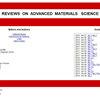Frost resistance and life prediction of recycled brick aggregate concrete with waste polypropylene fiber
IF 3.6
4区 材料科学
Q2 MATERIALS SCIENCE, MULTIDISCIPLINARY
引用次数: 0
Abstract
Due to recycled aggregate concrete technology, sustainable resource utilization can be achieved, but the weak frost resistance of this type of concrete affects its application in cold regions. Using waste polypropylene fibers as reinforcing materials can improve the mechanical properties and durability of concrete. This study explores the influence of waste polypropylene fiber on the frost resistance durability and microstructure of recycled brick aggregate (RA) concrete. The results show that with the increase in freeze–thaw cycles, the mass of the concrete first increases and then decreases, while its relative dynamic elastic modulus and compressive strength gradually decrease. After 60 freeze–thaw cycles, the maximum mass loss, maximum relative dynamic elastic modulus loss, and maximum compressive strength loss of the RA concrete are 1.73, 45.1, and 73.7%, respectively. Waste fiber (WF) can improve the frost resistance of concrete, as demonstrated by the obvious reduction in mass loss, relative dynamic elasticity modulus loss, and compressive strength loss, which are 0.11, 33.0, and 64.0%, respectively, after 60 freeze–thaw cycles. The action mechanism of WF on the frost resistance of RA concrete is revealed, and the life prediction model of RA concrete with WF under freeze–thaw conditions is established.含有废聚丙烯纤维的再生砖骨料混凝土的抗冻性和寿命预测
由于采用了再生骨料混凝土技术,可实现资源的可持续利用,但这种混凝土的抗冻性较弱,影响了其在寒冷地区的应用。使用废聚丙烯纤维作为增强材料可以改善混凝土的力学性能和耐久性。本研究探讨了废聚丙烯纤维对再生砖骨料(RA)混凝土抗冻耐久性和微观结构的影响。结果表明,随着冻融循环次数的增加,混凝土的质量先增大后减小,而相对动弹性模量和抗压强度则逐渐减小。经过 60 次冻融循环后,RA 混凝土的最大质量损失、最大相对动态弹性模量损失和最大抗压强度损失分别为 1.73%、45.1% 和 73.7%。废纤维(WF)可以提高混凝土的抗冻性,具体表现在经过 60 次冻融循环后,混凝土的质量损失、相对动态弹性模量损失和抗压强度损失明显降低,分别为 0.11%、33.0% 和 64.0%。揭示了 WF 对 RA 混凝土抗冻性的作用机理,建立了冻融条件下含 WF 的 RA 混凝土的寿命预测模型。
本文章由计算机程序翻译,如有差异,请以英文原文为准。
求助全文
约1分钟内获得全文
求助全文
来源期刊

Reviews on Advanced Materials Science
工程技术-材料科学:综合
CiteScore
5.10
自引率
11.10%
发文量
43
审稿时长
3.5 months
期刊介绍:
Reviews on Advanced Materials Science is a fully peer-reviewed, open access, electronic journal that publishes significant, original and relevant works in the area of theoretical and experimental studies of advanced materials. The journal provides the readers with free, instant, and permanent access to all content worldwide; and the authors with extensive promotion of published articles, long-time preservation, language-correction services, no space constraints and immediate publication.
Reviews on Advanced Materials Science is listed inter alia by Clarivate Analytics (formerly Thomson Reuters) - Current Contents/Physical, Chemical, and Earth Sciences (CC/PC&ES), JCR and SCIE. Our standard policy requires each paper to be reviewed by at least two Referees and the peer-review process is single-blind.
 求助内容:
求助内容: 应助结果提醒方式:
应助结果提醒方式:


